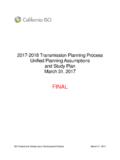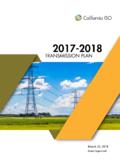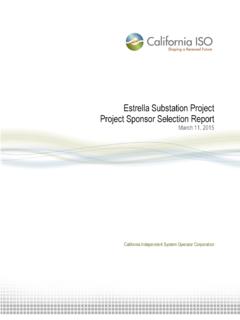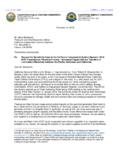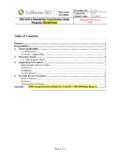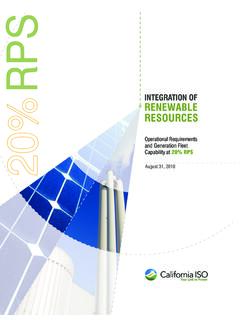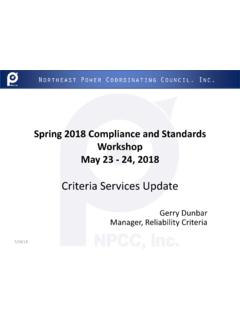Transcription of Agenda Unified Planning Assumptions & Study Plan
1 Agenda Unified Planning Assumptions & Study plan Jody Cross Stakeholder Engagement and Policy Specialist 2018-2019 Transmission Planning process Stakeholder Meeting February 28, 2018. California ISO Public 2018-2019 Transmission Planning process Stakeholder Meeting - Agenda Topic Presenter Introduction Jody Cross Overview & Key Issues Jeff Billinton Reliability Assessment Binaya Shrestha Economic Assessment Yi Zhang LCR Studies Catalin Micsa Wrap-up & Next Steps Jody Cross Page 2. California ISO Public Overview Unified Planning Assumptions & Study plan Jeff Billinton Manager, Regional Transmission - North 2018-2019 Transmission Planning process Stakeholder Meeting February 28, 2018. California ISO Public 2018-2019 Transmission Planning process January 2018 April 2018 March 2019. Phase 1 Develop Phase 2 - Sequential detailed Study plan technical studies State and federal policy Reliability analysis Renewable (policy- Phase 3.)
2 CEC - Demand forecasts driven) analysis Procurement CPUC - Resource forecasts Economic analysis and common Assumptions with procurement processes Publish comprehensive transmission plan with Other issues or concerns recommended projects ISO Board for approval of transmission plan California ISO Public 2018-2019 Transmission plan Milestones Draft Study plan posted on February 22. Stakeholder meeting on Draft Study plan on February 28. Comments to be submitted by March 14. Final Study plan to be posted on March 31. Preliminary reliability Study results to be posted on August 15. Stakeholder meeting on September 20 and 21. Comments to be submitted by October 5. Request window closes October 15. Preliminary policy and economic Study results on November 16. Comments to be submitted by November 30. Draft transmission plan to be posted on January 31, 2019. Stakeholder meeting on February Comments to be submitted within two weeks after stakeholder meeting Revised draft for approval at March Board of Governor meeting Page 3.
3 California ISO Public Planning and procurement overview CEC &. 1. Create demand forecast CPUC & assess resource needs feed into With input from ISO, IOUs & other Creates ISO 2. feed into stakeholders transmission plan With input from CEC, CPUC, IOUs & other stakeholders CPUC 3 Creates procurement plan Final plan With input from 4 authorizes procurement CEC, ISO, IOUs &. other stakeholders IOUs Results of 2-3-4 feed into next biennial cycle California ISO Public 2018-2019 Transmission plan Study plan Reliability Assessment to identify reliability-driven needs Policy Assessment No base portfolio will be transmitted to the ISO as part of the 2018-2019. TPP policy-driven assessment The IRP 42 MMT Scenario portfolio will be studied as a sensitivity in the 2018-2019 TPP policy-driven assessment to identify Category 2. transmission based on the CPUC IRP Reference System plan Economic Planning Study to identify needed economically-driven elements Local Capacity Requirements Near-Term.
4 Mid-Term; and Long-Term Long-term Congestion Revenue Rights Special Studies Page 5. California ISO Public Key Issues in 2018-2019 Transmission plan Cycle: Focus on renewable integration issues both in-front-of and behind-the-meter resources A major economic Study being focused on local capacity areas Special studies targeting: ISO support for CPUC proceeding re Aliso Canyon Potential for increasing opportunities for transfers of low carbon electricity with the PAC Northwest, and for PAC Northwest Hydro to play role in reducing dependence on resources impacted by Aliso Canyon Interregional projects will be addressed as per tariff-defined processes: The ISO is not Planning additional special Study efforts at this time focusing on out-of-state renewables given the recently completed studies spanning the 2016-2017 and 2017-2018 Planning cycles. Page 6. California ISO Public Study Information Final Study plan will be published March 31st Base cases will be posted on the Market Participant Portal (MPP).
5 For reliability assessment in Q3. Market notices will be sent to notify stakeholders of meetings and any relevant information Stakeholder comments Stakeholders requested to submit comments to: Stakeholder comments are to be submitted within two weeks after stakeholder meetings ISO will post comments and responses on website Page 7. California ISO Public Questions Stay connected Sign up for the @California_ISO Download ISO Today Daily Briefing at mobile app Page 8. California ISO Public Reliability Assessment Unified Planning Assumptions & Study plan Binaya Shrestha Regional Transmission Engineer Lead 2018-2019 Transmission Planning process Stakeholder Meeting February 28, 2018. California CaliforniaISO. ISOP ublic Public Planning Assumptions Reliability Standards and Criteria California ISO Planning Standards NERC Reliability Criteria TPL-001-4. WECC Regional Criteria TPL-001-WECC-CRT-3.
6 Page 2. California ISO Public Planning Assumptions (continued). Study Horizon 10 years Planning horizon near-term: 2019 to 2023. longer-term: 2024 to 2028. Study Years near-term: 2020 and 2023. longer-term: 2028. Page 3. California ISO Public Study Areas Northern Area - Bulk PG&E Local Areas: Humboldt area North Coast and North Bay area North Valley area Central Valley area Greater Bay area: Greater Fresno area;. Kern area;. Central Coast and Los Padres areas. Southern Area Bulk SCE local areas: Tehachapi and Big Creek Corridor North of Lugo area East of Lugo area;. Eastern area; and Metro area SDG&E area Bulk transmission Sub-transmission Valley Electric Association area ISO combined bulk system Page 4. California ISO Public Transmission Assumptions Transmission Projects Transmission projects that the ISO has approved will be modeled in the Study base case Projects recommended to proceed with revised scope will be modeled with the revised scope Canceled and on-hold projects will not be modeled Reactive Resources The Study models the existing and new reactive power resources in the base cases to ensure that realistic reactive support capability will be included in the Study Protection Systems The major new and existing SPS, safety nets, and UVLS that will be included in the Study Continue to include RAS models and work with PTOs to obtain remaining RAS models.
7 Control Devices Several control devices were modeled in the studies Page 5. California ISO Public Load Forecast Assumptions Energy and Demand Forecast California Energy Demand Revised Forecast 2018-2030 adopted by California Energy Commission (CEC) on February 21, 2018 will be used: Using the Mid Baseline LSE and Balancing Authority Forecast spreadsheets Additional Achievable Energy Efficiency (AAEE) and Additional Achievable PV (AAPV). Consistent with CEC 2017 IEPR. Mid AAEE/AAPV will be used for system-wide studies Low AAEE/AAPV will be used for local studies CEC forecast information is available on the CEC website at: Page 6. California ISO Public Load Forecast Assumptions Energy and Demand Forecast (continued). Load forecasts to be used for each of the reliability assessment studies. 1-in-10 weather year, mid demand baseline case with low AAEE/AAPV load forecasts will be used in PG&E, SCE, SDG&E, and VEA local area studies including the studies for the local capacity requirement (LCR) areas 1-in-5 weather year, mid demand baseline case with mid AAEE/AAPV load forecast will be used for bulk system studies Page 7.
8 California ISO Public Load Forecast Assumptions Methodologies to Derive Bus Level Forecast The CEC load forecast is generally provided for the larger areas and does not provide the granularity down to the bus-level which is necessary in the base cases for the reliability assessment The local area load forecast are developed at the bus- level by the participating transmission owners (PTOs) . Descriptions of the methodologies used by each of the PTOs to derive bus-level load forecasts using CEC data as a starting point are included in the draft Study plan . Page 8. California ISO Public Load Forecast Assumptions Self-Generation PV component of the self-generation in the CEC demand forecast will be modeled explicitly in the 2018-2019 TPP. base cases. Amount of the self-generation PV to be modeled will be based on 2017 IEPR data. Location to model self-generation PV will be identified based on location of existing behind-the-meter PV, information from PTO.
9 On future growth and behind-the-meter PV capacity by forecast climate zone information from CEC. Output of the self-generation PV will be selected based on the time of day of the Study using the end-use load and PV shapes for the day selected. Composite load model CMPLDWG will be used to model the self-generation PV. Page 9. California ISO Public Load Forecast Assumptions AAEE & AAPV. AAEE will be modeled using the CEC provided busbar allocations. AAPV will be modeled explicitly similar to the baseline self-gen PV. Amount of the AAPV to be modeled will be based on 2017 IEPR. data. Location to model AAPV will be identified based on analysis developed by the CPUC and in working with the three IOUs. Output of the AAPV will be selected based on the time of day of the Study using the end-use load and PV shapes for the day selected. Page 10. California ISO Public Supply Side Assumptions Continued coordination with CPUC Integrated Resource plan (IRP) on supply side Assumptions CPUC draft Unified Resource Adequacy and Integrated Resource plan Inputs and Assumptions Guidance for Production Cost Modeling and Network Reliability Studies es/Energy/EnergyPrograms/ElectPowerProcu rementGeneration/irp/2018/1U.
10 Renewable resources based upon the IRP 50% RPS Default Scenario Mapping of resource locations based the following provided to the CPUC by the CEC. 03/TN222569_20180215T155902_Energy_Commi ssion_Staff_Proof_of_Co Page 11. California ISO Public Generation Assumptions One-year operating cases 2-5-year Planning cases Generation that is under construction (Level 1) and has a planned in-service date within the time frame of the Study ;. Conventional generation in pre-construction phase with executed LGIA and progressing forward will be modeled off-line but will be available as a non-wire mitigation option. OTC repowering projects will be modeled in lieu of existing resources as long as they have power purchase approval from the CPUC or other Local Regulatory Agency (LRA). The contracted resources considered to be baseline Assumptions for selecting the CPUC's Default Portfolio will be utilized for modeling specific generation.
